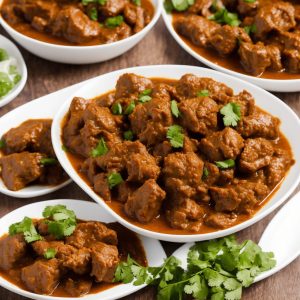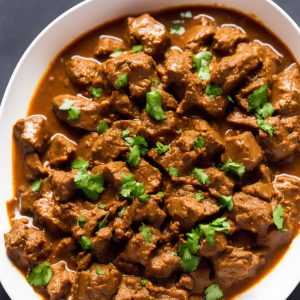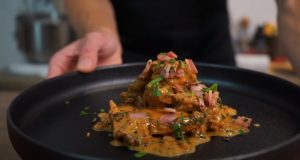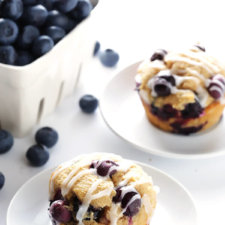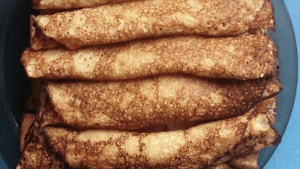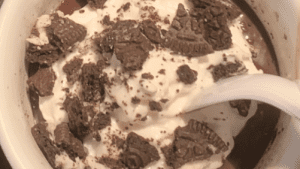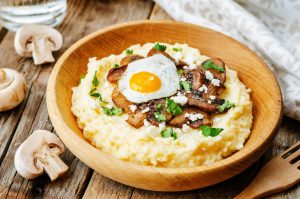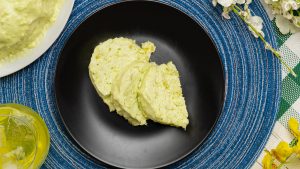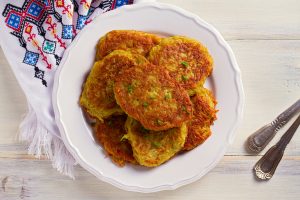Dive into the rich and creamy world of Malaysian cuisine with this delightful coconut jam known as kaya. This luscious spread, made from coconut milk and coconut cream, is perfect for adding a tropical twist to your breakfast toast. Infused with the aromatic essence of pandan leaves, this jam is a beloved staple in Malaysian households.
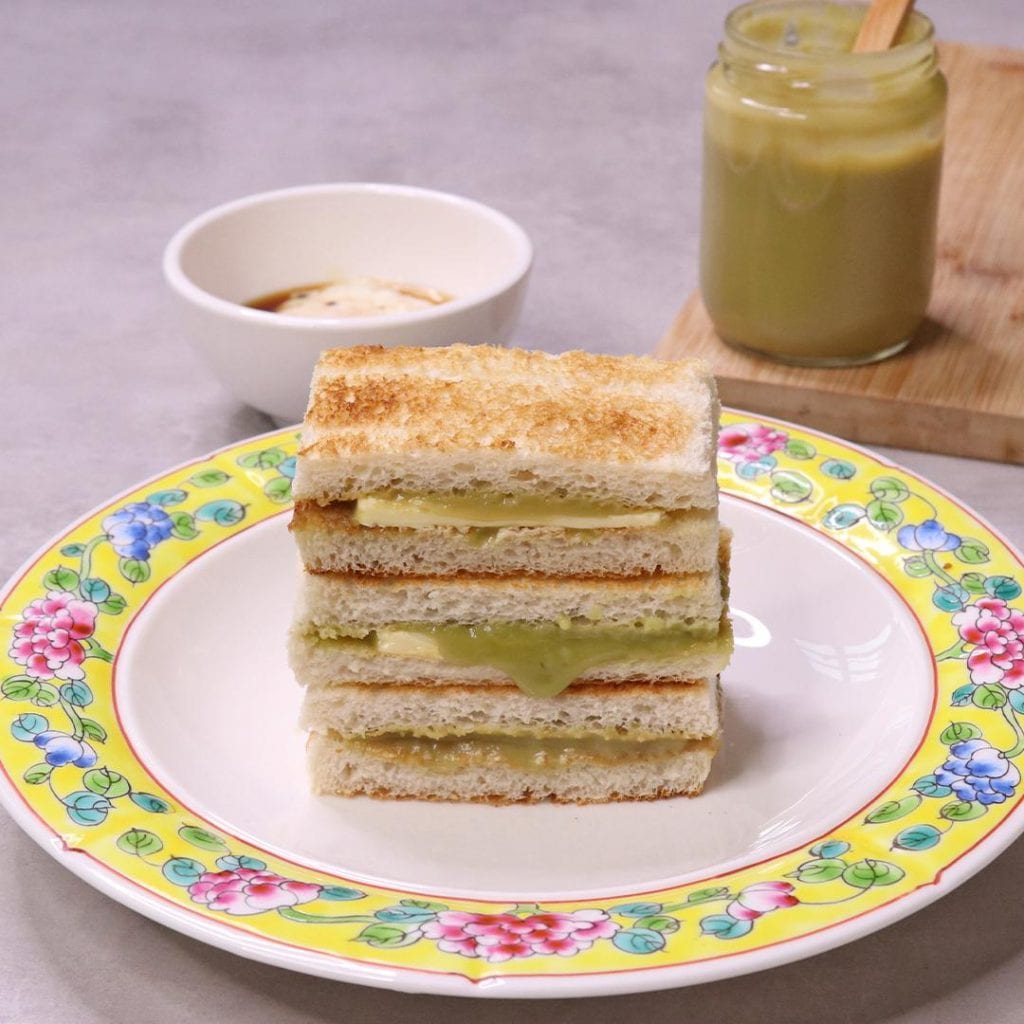
Photos of Malaysian Coconut Jam (Kaya) Recipe
For those unfamiliar with some of the ingredients, pandan leaves are used for their unique fragrance and flavor. These might not be available in every supermarket but can often be found in Asian grocery stores. Similarly, coconut cream and coconut milk are crucial for achieving the right consistency and flavor but make sure to get the unsweetened versions.
Ingredients For Malaysian Coconut Jam (Kaya)
eggs: Essential for the custard-like consistency of the kaya.
coconut milk: Provides richness and a subtle coconut flavor.
coconut cream: Adds extra creaminess to the jam.
sugar: Sweetens the kaya and helps in achieving the caramel flavor.
cornstarch: Used as a thickening agent to ensure the right texture.
water: Needed to blend the pandan leaves and dissolve the cornstarch.
pandan leaves: Infuses the kaya with a distinctive, fragrant aroma.
butter: Adds richness when serving on toast.
soy sauce: Used to season the soft-boiled eggs served alongside.
pepper: Adds a touch of spice to the soft-boiled eggs.
One reader, Ally Lovato says:





This Malaysian coconut jam (kaya) recipe is a delightful treat! The rich, creamy texture paired with the aromatic pandan flavor is simply heavenly. Perfect on toast with a soft boiled egg on the side. A must-try for any breakfast lover!
Techniques Required for Making Malaysian Coconut Jam
Yes.
How to blend pandan leaves: Blend pandan leaves with water until smooth, then strain through a sieve to extract the liquid.
How to make caramel: Add sugar to a pan on medium heat and allow it to melt completely until it turns golden brown.
How to combine cornstarch and water: Mix cornstarch with water until it forms a smooth slurry, then pour into the mixture and stir rapidly until it starts to thicken.
How to run kaya through a sieve: Pour the kaya mixture through a fine sieve to remove any lumps and achieve a smooth texture.
How to serve with soft boiled egg: Boil an egg until the white is set but the yolk remains runny, then serve with a dash of soy sauce and pepper.
How To Make Malaysian Coconut Jam (Kaya)
A delicious recipe for Malaysian coconut jam, or Kaya, that has an incredible toasted coconut flavor, perfect for steaming buns or toast!
Serves:
Ingredients
- 4eggs
- 1cupcoconut milk
- 1cupcoconut cream
- 1cupsugar
- 1tbspcornstarch
- 1tbspwater
For Pandan Extract:
- 5pandan leaveshalved
- 3tbspwater
For Caramel:
- ½ cup sugar
For Serving:
- 2slicestoastcrust removed
- 1tbspbutter
- soft boiled egg
- 1tspsoy sauce
- pepperto taste
Instructions
Pandan Extract:
-
Blend pandan leaves with water, then strain through a sieve.
-
Add coconut milk, coconut cream, eggs, pandan extract, and sugar to a bowl. Mix thoroughly then add to a saucepan.
-
Place the saucepan on very low heat and continuously stir for approximately 20 minutes. Be careful not to let the pan get too hot or the eggs will cook too quickly.
-
Combine cornstarch and water, then pour into mixture and stir rapidly until it starts to thicken.
Caramel:
-
Add sugar to a pan on medium heat and allow to completely melt until golden brown. Add the caramel to the Kaya and stir until completely dissolved.
-
Run kaya through a sieve, then store in a mason jar. Refrigerate overnight until set.
Serving:
-
Add a slice of butter to toast then dollop with a spoonful of Kaya, and add the other slice of toast on top. Serve with a soft boiled egg with a dash of soy sauce and pepper on the side.
-
Enjoy!
Nutrition
- Calories: 1031.43kcal
- Fat: 16.19g
- Saturated Fat: 12.99g
- Trans Fat: 0.05g
- Monounsaturated Fat: 1.55g
- Polyunsaturated Fat: 0.62g
- Carbohydrates: 226.54g
- Fiber: 1.07g
- Sugar: 219.94g
- Protein: 4.28g
- Cholesterol: 67.04mg
- Sodium: 89.20mg
- Calcium: 33.63mg
- Potassium: 182.68mg
- Iron: 2.13mg
- Vitamin A: 38.40µg
- Vitamin C: 1.05mg
Crucial Technique Tips for Perfecting Your Kaya
When making caramel, ensure that the sugar is evenly spread in the pan and avoid stirring it while it melts. Instead, gently swirl the pan to help the sugar melt evenly and prevent crystallization.
Time-Saving Tips for Preparing Kaya
Prepare ingredients in advance: Measure out coconut milk, coconut cream, and sugar ahead of time to streamline the cooking process.
Use pre-made pandan extract: If available, use store-bought pandan extract to save time on blending and straining pandan leaves.
Cook in a double boiler: To avoid overheating, use a double boiler setup for more controlled cooking, reducing the need for constant stirring.
Make caramel in bulk: Prepare extra caramel and store it for future use, cutting down on preparation time for subsequent batches.
Toast in the oven: Toast multiple slices of bread in the oven simultaneously to save time compared to using a toaster.
Substitute Ingredients For Malaysian Coconut Jam (Kaya) Recipe
eggs - Substitute with silken tofu: Silken tofu can mimic the texture of eggs and provide a similar binding effect in the recipe.
coconut milk - Substitute with almond milk: Almond milk can provide a similar creamy texture, though it will alter the flavor slightly.
coconut cream - Substitute with heavy cream: Heavy cream can replicate the richness of coconut cream, though it will not have the same coconut flavor.
sugar - Substitute with honey: Honey can be used as a natural sweetener, though it will add a different flavor profile to the jam.
cornstarch - Substitute with arrowroot powder: Arrowroot powder can act as a thickening agent similar to cornstarch.
pandan leaves - Substitute with vanilla extract: Vanilla extract can provide a different but pleasant flavor if pandan leaves are not available.
sugar (for caramel) - Substitute with maple syrup: Maple syrup can be used to create a caramel-like flavor and consistency.
toast - Substitute with rice cakes: Rice cakes can be used as a gluten-free alternative to toast.
butter - Substitute with margarine: Margarine can be used as a dairy-free alternative to butter.
soft boiled egg - Substitute with poached egg: A poached egg can provide a similar texture and flavor to a soft boiled egg.
soy sauce - Substitute with tamari: Tamari is a gluten-free alternative to soy sauce with a similar taste.
pepper - Substitute with white pepper: White pepper can be used as an alternative to black pepper for a slightly different flavor.
Presenting Kaya: A Delightful Malaysian Coconut Jam
Use artisanal bread: Select high-quality, freshly baked toast to elevate the dish. Slice it evenly and toast to a perfect golden brown.
Butter precision: Apply butter evenly on the toast to ensure a rich, creamy base for the kaya. Use a small offset spatula for precision.
Elegant kaya dollop: Spoon a generous yet refined dollop of kaya onto the toast. Use a quenelle technique to create a smooth, elegant presentation.
Soft-boiled egg perfection: Cook the soft boiled egg to perfection, ensuring the yolk is runny and the white is just set. Carefully peel and place in a small, elegant dish.
Soy sauce and pepper garnish: Add a dash of soy sauce and a sprinkle of freshly ground pepper to the soft boiled egg. Use a small pipette for the soy sauce to control the amount and placement.
Layered presentation: Place the toast with kaya on a sleek, modern plate. Add the second slice of toast on top, slightly askew to show the layers.
Garnish with pandan: Use a small piece of pandan leaf as a garnish on the plate to hint at the pandan extract used in the kaya. This adds a touch of color and elegance.
Serve with finesse: Present the dish with the soft boiled egg in its own small dish, placed beside the toast. Ensure the plate is clean and free of any smudges or drips.
Attention to detail: Use tweezers to place any small garnishes or to adjust the presentation. Every element should look intentional and refined.
Essential Tools for Making Kaya
Blender: Used to blend the pandan leaves with water to create the pandan extract.
Sieve: Used to strain the blended pandan mixture to get a smooth extract.
Mixing bowl: Used to mix the coconut milk, coconut cream, eggs, pandan extract, and sugar together.
Saucepan: Used to cook the kaya mixture on very low heat.
Wooden spoon: Used to continuously stir the kaya mixture to prevent the eggs from cooking too quickly.
Small bowl: Used to combine the cornstarch and water before adding to the kaya mixture.
Whisk: Used to rapidly stir the cornstarch mixture into the kaya to help it thicken.
Pan: Used to melt the sugar for the caramel.
Mason jar: Used to store the kaya after it has been sieved.
Refrigerator: Used to set the kaya overnight.
Toaster: Used to toast the bread slices for serving.
Butter knife: Used to spread butter on the toast.
Spoon: Used to dollop kaya onto the toast.
Egg cooker: Used to make the soft boiled egg for serving.
Pepper grinder: Used to add a dash of pepper to the soft boiled egg.
Storing and Freezing Homemade Kaya
- Once the kaya has been cooked and strained, allow it to cool to room temperature before transferring it to an airtight container or mason jar.
- Seal the container tightly to prevent any air from entering, which can cause the kaya to spoil more quickly.
- Store the kaya in the refrigerator for up to 2 weeks. It will thicken and set as it chills, developing its characteristic smooth and spreadable texture.
- If you want to keep the kaya for longer, you can freeze it for up to 2 months:
- Transfer the cooled kaya to a freezer-safe container, leaving some headspace to allow for expansion during freezing.
- Label the container with the date of preparation and the contents.
- When you're ready to use the frozen kaya, thaw it overnight in the refrigerator.
- Give the thawed kaya a good stir before using, as some separation may occur during the freezing and thawing process.
- Always use clean utensils when scooping out the kaya to avoid introducing any bacteria that could cause spoilage.
- If you notice any signs of mold, off-smells, or unusual discoloration, discard the kaya immediately, as it may have gone bad.
How To Reheat Leftover Kaya
- To reheat leftover malaysian coconut jam (kaya), start by removing it from the refrigerator and allowing it to come to room temperature for about 30 minutes. This will help the jam to reheat more evenly and prevent it from becoming grainy or separated.
- Once the kaya has reached room temperature, you can reheat it using one of the following methods:
- Microwave: Transfer the desired amount of kaya to a microwave-safe bowl. Heat it in the microwave on medium power for 15-20 seconds at a time, stirring well between each interval, until the jam is warm and smooth.
- Stovetop: Place the desired amount of kaya in a small saucepan over low heat. Stir the jam continuously, making sure to scrape the bottom and sides of the pan to prevent scorching. Heat the kaya until it is warm and smooth, which should take about 3-5 minutes.
- Double boiler: Fill a pot with a few inches of water and bring it to a simmer. Place the desired amount of kaya in a heat-safe bowl that fits snugly over the pot without touching the water. Stir the jam occasionally as it warms up, until it reaches the desired temperature and consistency. This method is gentler and helps to prevent the jam from burning or becoming grainy.
- When reheating kaya, be careful not to overheat it, as this can cause the eggs in the jam to cook further and change the texture. Aim for a warm, smooth consistency, and remove the jam from the heat as soon as it reaches this stage.
- If you find that the reheated kaya has become a bit thick or grainy, you can stir in a small amount of coconut milk or water to help smooth it out and restore its creamy texture.
- Once the kaya is reheated, you can serve it immediately with toast, soft-boiled eggs, or any other desired accompaniments. Enjoy the warm, comforting flavors of this delicious Malaysian spread!
Fascinating Facts About Kaya
A unique aspect of Malaysian coconut jam (kaya) is its use of pandan leaves for flavoring, which gives the jam a distinct, aromatic fragrance.
Is Making Kaya at Home Cost-Effective?
The Malaysian coconut jam (kaya) recipe is quite cost-effective for a household. The primary ingredients like eggs, coconut milk, and sugar are relatively inexpensive and easily accessible. The use of pandan leaves might be slightly exotic, but they are affordable at Asian markets. The overall cost for a household of 4 people is approximately $10-$12 USD. Considering the delightful and unique flavor profile it brings, the overall verdict rating for this recipe is a solid 8 out of 10.
Is Malaysian Coconut Jam (Kaya) Healthy or Unhealthy?
The Malaysian coconut jam (kaya) recipe is a delicious treat, but it may not be the healthiest option due to its high sugar and fat content. Here's a breakdown of the recipe's nutritional aspects:
- The recipe contains a significant amount of sugar, with 1 cup of sugar in the kaya itself and additional sugar in the caramel.
- Coconut milk and coconut cream are high in saturated fats, which can raise cholesterol levels and increase the risk of heart disease if consumed in excess.
- The recipe also includes eggs, which are a good source of protein but also contribute to the overall cholesterol content.
- The serving suggestion includes white bread, which is a refined carbohydrate and may cause blood sugar spikes.
To make this recipe healthier, consider the following suggestions:
- Reduce the amount of sugar in the kaya by using a natural sweetener like stevia or monk fruit extract. You can also experiment with using ripe bananas or dates to add natural sweetness.
- Replace some of the coconut milk and cream with a lower-fat alternative, such as almond milk or light coconut milk.
- Use whole grain bread instead of white bread for serving to increase the fiber content and slow down the absorption of sugars.
- Add fresh fruit, such as sliced bananas or berries, to the toast to increase the nutritional value and provide additional fiber and vitamins.
- Serve the kaya in smaller portions and pair it with a protein-rich side dish, like a boiled egg, to help balance the meal and keep you feeling full for longer.
Editor's Opinion on This Delectable Coconut Jam Recipe
This Malaysian coconut jam (kaya) recipe is a delightful blend of rich coconut flavors and aromatic pandan. The process of making pandan extract and caramel adds depth and complexity. The key is to maintain a low heat to avoid curdling the eggs, ensuring a smooth, luscious texture. Serving it with buttered toast and a soft-boiled egg with soy sauce and pepper creates a harmonious balance of sweet and savory. This recipe is a wonderful way to experience traditional Malaysian flavors in a comforting and indulgent spread.
Enhance Your Malaysian Coconut Jam (Kaya) Recipe with These Unique Side Dishes:
Delicious Alternatives to Malaysian Coconut Jam
Why trust this Malaysian Coconut Jam (Kaya) Recipe:
This Malaysian coconut jam (kaya) recipe is a delightful blend of coconut milk, coconut cream, and pandan extract, creating a rich and aromatic spread. The step-by-step instructions ensure a smooth and creamy texture, while the addition of homemade caramel adds a depth of flavor. Perfectly paired with toast and a soft boiled egg, this traditional treat is both authentic and delicious. Trust this recipe for its balance of flavors and easy-to-follow method, promising a satisfying and indulgent experience.
Was this page helpful?
Have your own special recipe to share? Submit Your Recipe Today!

